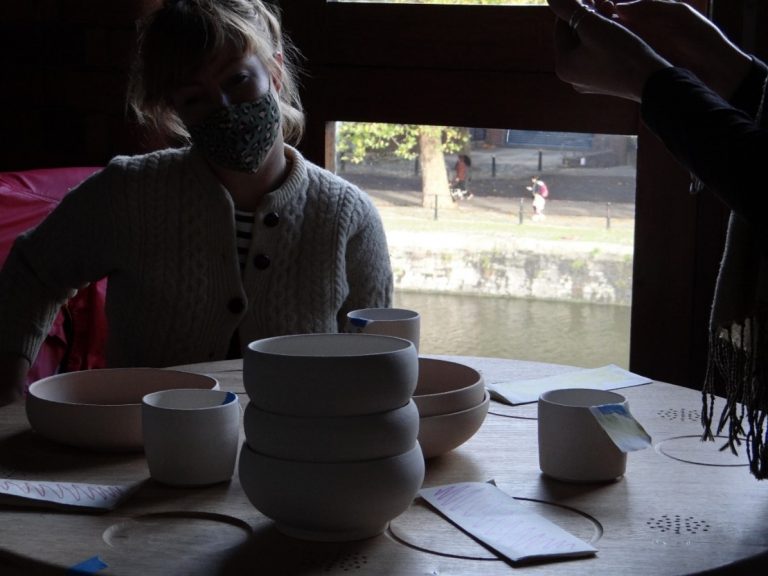 |
| Image credit: Brigstow Institute |
What is the most extreme temperature you have experienced?
Take your time and have a moment to think about it.
What was happening that day? Where were you? Which of your senses feature in the memory? Do any emotions come back to you?
While you’re thinking about it, I’ll tell you a little bit about the Temperature Life Stories project that I brought to COP26 on 1st November 2021.
We all experience temperature differently. The hottest day I remember might be very different from the hottest day you remember. Where we have been, when we were there and our specific circumstances at a given moment all affect the physical temperatures we have lived through. We have lived different temperature life stories.
Why does this matter? Even in the UK, in Glasgow where world leaders will be meeting for COP26, which we often think of as being cold and driech, some people will be at risk from extreme temperatures. Meanwhile, for some of us that have always lived in and become acclimatised to temperate climate zones, we may never appreciate the searing strength of heat experienced by others on a daily basis. What does “1.5 °C or 2 °C of global warming above pre-industrial temperatures” even mean for ourselves or individuals like us elsewhere in the world? Expressing our differences in circumstances in creative ways can help build new understandings and narratives of how we will live with temperature extremes in a warming world.
The Temperature Life Stories project explored these questions. By digging into global temperature data, the same data that informs global temperature targets, we produced temperature life story graphs for both individuals and our collective of research participants. As individuals we may never ‘feel’ the global average temperature, but our experience is part of that bigger picture. Memories and experiences of temperature were explored through poetry, with exercises designed by Caleb Parkin (Bristol City Poet, 2020-2022), and a host of other creative methods from the wonderful (and hidden) talents of our research participants.
Of course, there were and will be contradictions too. The temperature that the data says we lived through might not match what we remember as being the most extreme of days. But that’s okay: unreliable narrators are part of storytelling, aren’t they?
So back to COP26, what was Temperature Life Stories doing there? Of course, I would have loved to have run a series of poetry workshops with international COP26 delegates to take the temperature of the conference, but unfortunately for them, time is more of the essence. For that reason, I settled for a providing a tiny morsel of the project as a taster at the COP26 Green Zone.
I asked attendees to spare just one key memory from their temperature life story. Something that stood out for them. I asked for them to describe it in just a few lines, which could be as poetic or as factual as they pleased. I asked them where and when the memory occurred (being as specific as they could or wanted to be).
Often, relative warmth appears in the memories: perhaps not extreme in a global sense, but enough to seem unusual to locals and visitors alike in Yorkshire, the Hebridies, alpine and polar environments. Sometimes a lack of snow says as much as burnt brown grass. Travel appears regularly, making up a key part of temperature life stories – both the biting cold of northern climates after a lifetime spent nearer the tropics and vice versa. Even a momentary blast of air changing connecting flights in Qatar can give a glimpse of what temperatures are possible. We don’t expect similar blasts of heat to hit us getting off the train in Birmingham, but recent summer heatwaves featured regularly in memories too, and in with them that same wall of heat. Finally, there are emotions too: nostalgia about climates of home or childhood not being the same when people return after time spent away, sadness for places of significance lost in wildfires, weeks of unbroken heat and sunshine “both amazing and terrifying”.
Using this collection of memories, a bespoke map of experience, emotions and stories in space and time will be produced for the COP26 conference. An alternative story of a warming world. Keep an eye on Brigstow channels in the coming weeks for this.
So what about you? Have you been thinking of your memory of temperature? Maybe it was during last summer’s heatwave. Maybe you were on holiday. Maybe you were stuck in an unairconditioned bus in a traffic jam. Maybe the heat was emotional, not physical: passion, anger or embarrassment. There is no right or wrong answers – every story is different.
If you have a memory and want to add it to our collective COP26 story, you can add it here (https://forms.office.com/r/HnwesuwJqg). We’ll ask you for the same information as the Green Zone participants an all memories and data recorded is anonymous.
Together we can rewrite a new story of our warming world. One which shows our vulnerabilities, frailties and fears but also our lighter moments, hopes, achievements. We have a complex relationship with the weather and climate we experience. Sometimes a graph can’t say it all.
———————–
This blog is written by Cabot Institute member Dr Alan Kennedy-Asser from Brigstow Institute funded Experimental Partnership “Temperature Life Stories: Feeling the heat”. This blog has been reposted from the Bristow Institute blog with kind permission from the Brigstow Institute. View the original blog.



